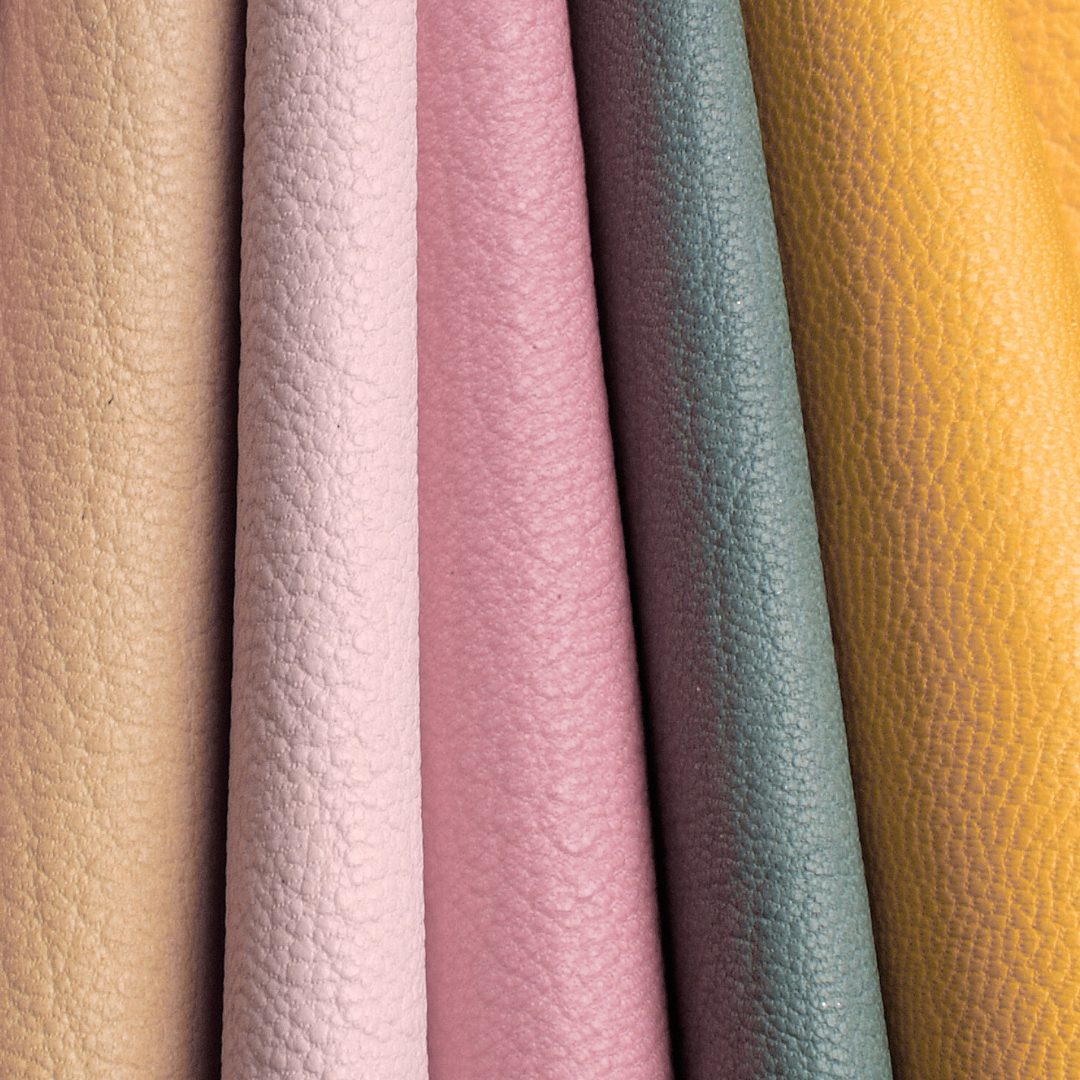
Let’s clear up the terminology: What is faux leather, vegan leather? Which is better: animal leather or vegan leather?
Let’s clear up the terminology: What is faux leather, vegan leather? Which is better: animal leather or vegan leather?
In short: each has its advantages and disadvantages. Choosing one or the other is a matter of personal decision, worldview, financial situation, and taste. What’s important to us is that we don’t look down on others for making a different choice—because the picture isn’t black and white. And since we’ve been working in this industry for over ten years, you can trust that we’ve looked at it from many angles and spoken to many professionals about it.
LEATHER
In the tanning of animal hides, a lot of chemicals are used. While they are less harmful to the end consumer, they are much more dangerous for the workers involved in production and for their environment. Most leather is produced in poorer regions—Italy is the exception, where premium quality is produced, rather than the mass-market varieties.
Chemicals used in leather production include:
-
Sodium sulfate (a base material used in cleaning products)
-
Sulfuric acid (a corrosive agent, one of the components of acid rain)
-
Formic acid (toxic in high quantities—liver and kidney damage; dangerous for workers)
-
Hydrogen sulfide (very toxic gas with a rotten egg smell)
-
Aniline-based dyes (aniline is a highly toxic compound)
-
Solvents
-
Formaldehyde (carcinogenic when inhaled)
-
Cellulose nitrate (no longer produced because of its explosive properties)
65% of leather comes from cattle, which means it already carries a heavy ecological footprint. And no, it’s not because cows are “farting the atmosphere to pieces,” as jokes in the media suggest. Cattle farming requires enormous amounts of water (for drinking and feeding) and huge amounts of land—land that could otherwise serve as farmland or forests. Feeding animals also doesn’t just mean wild plants: a part of the food industry exists solely to produce feed for livestock, which requires money, raw materials, and land.
Durability
In bags and shoes, it’s typically not the material itself that wears out, but the stitching. Both leatherworkers and faux-leather craftsmen use the same polyester thread. The same goes for metal parts and zippers (cotton or polyester), which are often more fragile than the base material. Faux leather requires cleaning; animal leather needs conditioning. Without these, both materials will get damaged over time.
THE COMPONENTS OF FAUX LEATHER
-
PVC (polyvinyl chloride): produced since 1912, a very resistant, rigid plastic. When burned, it releases pollutants. It’s produced in the world’s most developed countries (main producers: USA, Japan, Korea, Germany).
-
Polyester (PES): a durable plastic made from alcohols and dicarboxylic acids.
-
Polyurethane (PU): petroleum-based, durable, with favorable properties.
Sourcing: The largest exporter is China, but we use European materials—mainly Polish, Czech, Italian, and Irish—all of which carry REACH certification and ISO certificates. Some of these fabrics are made using recycled plastics.
ISO certificates show qualities such as salt- and water-resistance, tensile strength, thickness, abrasion resistance, etc.
REACH certificate: Ensures the protection of human health and the environment by regulating the manufacture and use of chemical substances.
The main ethical differences
In faux leather production, workers are not directly exposed to chemicals—the process is safe and takes place under controlled conditions. In leather tanning, workers and the environment are directly exposed to hazardous substances.
But isn’t leather a byproduct of the meat industry? Yes—but our purchases cast a vote. Do we demand that hides be tanned? If there’s no demand, there will be no production.
A bit of reading on this:
https://www.peta.org/issues/animals-used-for-clothing/leather-industry/leather-environmental-hazards/#:~:text=Leather%20has%20one%20of%20the,hypoxic%20zones%2C%20also%20known%20as
Durability of materials
From our experience, even 7–8–9 year old faux leather bags are still in use. Some we’ve repaired, but most didn’t need fixing. What usually fails are the replaceable parts: straps, metal hardware, thread.
For example, a LINE bag uses about 450 g of faux leather. If we assume just 5 years of use (which is actually less than reality), that equals the same amount of plastic used in toothpaste tubes over that time. Will it eventually become waste? Yes. Like everything that isn’t fully biodegradable.
According to Hannah Ritchie, one of today’s leading environmental researchers, the use of plastic is relative. The real problem is not plastic itself, but improper disposal—throwing it away on beaches, or not recycling it properly. She makes an even more surprising point: around 20% of the world’s food production ends up as waste. Without plastic packaging, even more would spoil during transport and storage.
Vegan or faux leather?
Both. The word “faux leather” has a negative ring to it, associated with the poor-quality fakes of previous decades. But modern faux leathers are much higher quality—the industry has improved tremendously. Some criticize the term “vegan leather” as just trendy branding. But the truth is, many consumers can’t even tell faux leather apart from animal leather anymore. And the word “vegan leather” belongs to a subcultural vocabulary: people who avoid buying anything that harms animals—whether clothing, food, or cosmetics.
It’s the same in cosmetics: a product is considered vegan not because it contains plants, but because it lacks animal-derived ingredients. (Look up lanolin, for example.)
Plant-based alternatives: the “true” vegan leathers
Are plant-based leathers a real alternative? Partly. They’re usually up to 70% plant-based, with the rest still plastic (PVC, PES, PU). Since these are new materials, their durability is not yet proven. They are still expensive to produce, difficult (and costly) to source, leave a large carbon footprint in transport (because of low pallet efficiency), and supplies are inconsistent.
Still, it’s a promising direction. We hope they will become more available in the future. As demand grows, prices will drop, and logistics will become more efficient.
The consumer’s choice
It’s up to the consumer to make the decision they feel comfortable with:
-
Choose an ethically questionable material that biodegrades within decades (though chemicals may still enter the soil) but lasts 10–15 years, meaning you won’t buy a replacement for a long time.
-
Or choose a cleanly produced material that doesn’t endanger workers or exploit animals, but doesn’t biodegrade—yet still lasts 5–8 years at least.
And let’s be honest: in fashion, that’s often more than enough time before someone wants a new piece. Zero-waste living begins on a very different level—and to some extent, it’s an illusion. Thankfully, the recycling industry is advancing rapidly, and soon PVC or PU-based materials will be fully recyclable.
If you want to see this topic with a clear perspective—beyond arguments, influencer posts, trends, and outrage—we recommend reading Hannah Ritchie’s book Not the End of the World (currently available only in English). Hannah clears up the concepts and gives reasons for optimism about our future. She also stresses that no material is inherently good or bad—it’s how we use and manage it that matters. And she quickly shatters our illusions: humanity has been polluting the environment ever since we first lit a piece of wood on fire.
